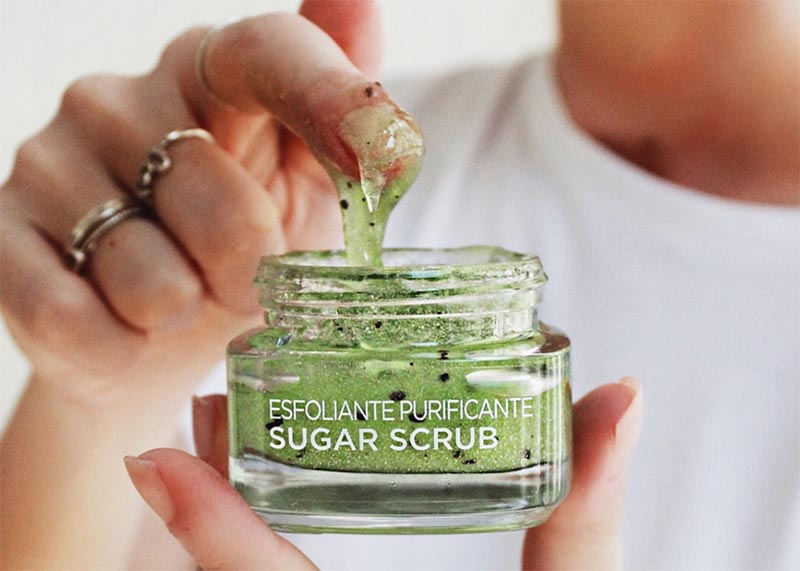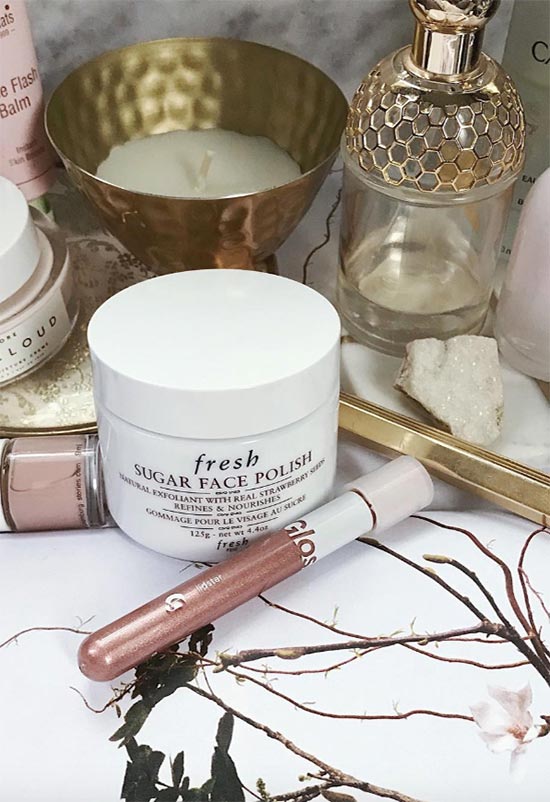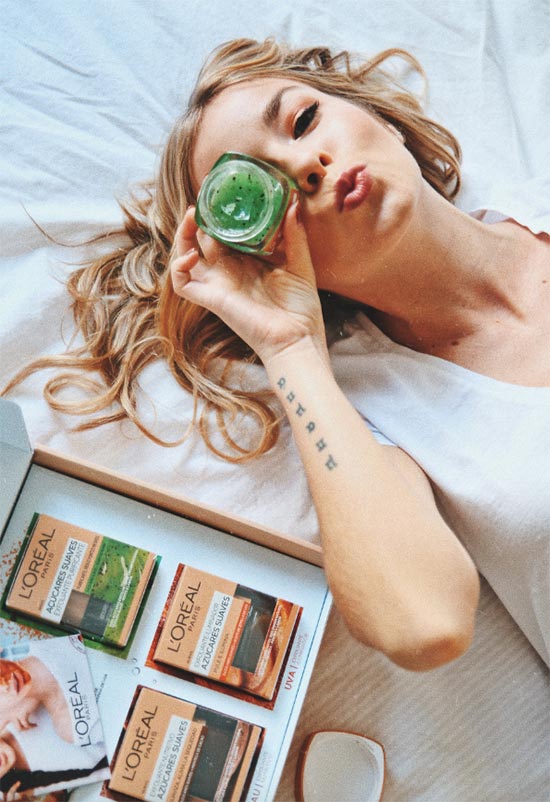While chemical exfoliators are almost always preferred to physical ones, if you know how to use facial scrubs properly you’ll benefit from these skincare products too in the long run. In this article, we’ll make sure you know exactly what face scrubs are, how they work, including based on skin type, so you can choose the right face exfoliators for you. We also list directions so that you know how to use face scrub to exfoliate skin properly. What are you waiting for? Get scrubbing!
In this article:
- Face Scrub Benefits
- Types of Facial Exfoliators
- Physical Facial Scrub Pros and Cons
- Chemical vs. Physical Exfoliation
- How to Exfoliate Face Using a Facial Scrub
- Other Face Scrubbing Tips to Know
Face Scrub Benefits
Face scrubs are so simple, but they make such a difference. Face scrubs are made up of small, abrasive pieces that, when rubbed into the skin, work to dislodge dead skin. Think about them like ulta-gentle sand paper for the face that rubs against the skin to make it smooth and polished.
By dislodging dead skin scrubbing has all kinds of wonderful effects on the skin.
- Dead skin build-up can cause all kinds of texture issues in the skin. By removing that build-up, the skin instantly feels softer and smoother. Over time scrubbing can also have a remarkable effect over more serious texture issues like scarring or hyperpigmentation.
- Excess dead skin on the stratum corneum (the top layer of the epidermis) can have an impact on the lowers layers. It can prevent new skin cells from forming adequately or as quickly. By exfoliating the skin you can ensure that the skin cell regeneration process keeps running smoothly, to keep your skin looking healthy and youthful.
- Moisturizers and serums simply cannot penetrate as well into the skin when it has a thick layer of dead skin sitting on top of it. Scrubbing the skin increases the skin’s ability to take in moisture and active ingredients from all kinds of products to ensure that they can do their best to improve the health and beauty of your skin.
- Build-up of dead skin really brings out and magnifies skin texture issues, including large pores, fine lines, and wrinkles. With exfoliation you can instantly remove that dead skin and quickly minimize the look of pores and fine line and wrinkles.
- Some people, especially those with dry skin, find that they can get dry patches or areas of flakey skin. Face exfoliators are the quickest solution, as they instantly remove the flakey skin and make the face look smoother.
- Blackheads, whiteheads, and pimples are all formed partially because of dead skin clogging the pores. Exfoliation helps to prevent those clogged pores in the first place, which keeps the skin clear. It can also slowly work to dislodge cloggings, and over time reduce the look of blackheads and whiteheads.
When the skin has pimples, however, it is better to avoid scrubbing since it can irritate the already inflamed skin and spread bacteria around.
Types of Facial Exfoliators and the Differences Between Them
In addition to all of these benefits, the best face exfoliators also contain other ingredients that will improve the look of the skin. Keep reading this article to learn what kind of face scrubs will have unique benefits for your skin type.

Traditional Facial Scrubs
Most of face scrubs are simply made as facial cleansers that had some abrasive pieces added to them. This is the most common way in which face scrubs are formulated.
They work double duty to both remove dead skin and to clean the face, and they tend to be the best face scrubs for those with oily skin. Companies often recommend using them as a two-in-one, instead of a cleanser, but I think that it’s best to only exfoliate the skin when it’s clean, so I wouldn’t recommend skipping cleansing before exfoliating.
Scrub and Mask in One
These kinds of face scrubs are more like face masks that have had some abrasive elements added to them. I am a big fan of these, because you can simply apply them to the skin, rub them in a little to exfoliate, and then let them sit and nourish your skin.
They’re two-in-one products that actually work to beautify the skin and save time. Some of these masks/ scrubs are made with clay, and are better suited to those with oily skin. Others are made with nourishing extracts, hydrators, and oils, and they really help improve the look of dry skin.
Oil-Based Scrubs
Sugar and salt scrubs often fall into this face exfoliators category. They are made up primarily of the abrasive material, which sits in some kind of skincare oil.
These kinds of scrubs are more common for the body than for the face. If you do want to try an oil-based face scrub, keep in mind that they tend to work better for those with dry skin.
Dry Scrubs
Dry scrubs or exfoliating powders are a recent addition to the cosmetics market, which is quite surprising, since they are such a simple yet brilliant product. These are dry powders, normally sold in a glass jar, that are meant to be combined with water, oil, or cleanser in order to make a semi-DIY face scrub.
They are great for people whose skin acts differently from week to week, since they can play around with the other ingredients based on their skin’s needs. These are also very easy to prepare at home.
They are usually made of a dry bean powder, rice powder, or oatmeal powder, although occasionally you’ll also see blends with clay in the mix.
Facial Cleansing Brushes
Another popular way of manually exfoliating the skin is with facial cleansing brushes. These brushes exfoliate the skin during cleansing, with lightly abrasive bristles. Some are very simple, while others are battery powered electrical tools like the Clarisonic.
Chemical Exfoliants
I go into more detail later on, but chemical exfoliants like glycolic or lactic acid are not scrubs. They usually come in the form of a toner or serum, and they are made up of acids that melt down the glue that connects dead skin cells together, forcing them to shed themselves. Most people will use either a physical scrub or a chemical scrub, although some actually enjoy a routine with both.
Physical Facial Scrub Pros and Cons
Pros
- Physical face scrubs are very easy to use and to fit into a pre-existing skincare routine, especially when compared to chemical exfoliators.
- Face exfoliators have an instant effect of removing dead skin and improving the overall look of the skin.
- By removing dead skin, face scrubs ensure that serums and moisturizers penetrate into the skin better and have a stronger effect.
- For those whose skin does not tolerate chemical exfoliants like glycolic or salicylic acid, face scrubs make for a great alternative.
Cons
- Physical scrubs can irritate sensitive skin, especially if they are over-used, since they remove dead skin through an abrasive action.
- Face scrubs are not a good choice for those with acne-prone skin, physical scrubs can break pimples open and spread bacteria around.
- Physical scrubs made with plastic microbeads can have a terrible effect on the environment. Since the microbeads cannot be filtered out, they end up in lakes and oceans, and can seriously harm the ecosystems there. These days many countries are banning plastic microbeads, and you’ll be happy to know that all of the best scrubs that I’ve listed are perfectly safe for the environment.
- With an improperly formulated face scrubs the exfoliation can simply not be thorough enough, or it can be done with exfoliating bits that have sharp edges that scratch the skin instead of exfoliating it – this is something to keep in mind.

Chemical vs. Physical Exfoliation: Which One Is Right for You?
You probably already know, but generally I prefer to recommend chemical exfoliants. Acid based chemical exfoliants with glycolic, lactic, or salicylic acids simply have an amazing effect on the skin.
These acids penetrate through the top layers of the epidermis, and melt down the sebum that keeps dead skin cells connected. This allows them to shed from the skin in a way that is very gentle and comprehensive.
Additionally, chemical exfoliants tend to have either a humectant effect on the skin, so they leave it more hydrated, or they can have an anti-inflammatory effect that reduces irritation.
On the other hand, face scrubs dislodge the dead skin cells manually. By rubbing the skin with the scrub the little abrasive bits have a sandpaper like effect on the skin. This can be very effective, but it can also irritate those who have sensitive skin or spread bacteria from acne around by popping the pimple.
You can think of it like this: chemical exfoliants work from below to essential push off or make the dead skin cells easier to remove, while face scrubs work from above, to dislodge the dead skin cells manually. Some people find that a routine that includes both a face scrub and a chemical exfoliator works best for them, since they get both the exfoliation from above and the exfoliation from below.
With all this in mind, I actually prefer only using face scrubs in my routine, albeit very gently and sparingly. While I know that chemical exfoliants are usually the better choice, I don’t like how they make my skin appear a little flakey, as the dead skin cells start to come off.
I also don’t like that they make the skin more prone to sunburn, since I already burn easily. That is my personal reason for only using face scrubs.
How to Exfoliate Face Using a Facial Scrub
Simply scrubbing the skin is not enough – you need to exfoliate the right way, as part of a comprehensive skincare routine that will keep you glowing and healthy. These are comprehensive instructions for exfoliation that will work with most face scrubs.
While some brands recommend that you use their face exfoliators every day, I recommend you exfoliate your skin following these instructions only 3-4 times a week at the most.
- Cleanse
You always want to start with thoroughly cleansed skin. Clean your skin with a gentle cleanser that has a low pH, or you can even try the oil cleansing method if you’re going to be using a face scrub in an abrasive cleanser formula.
- Wet or Dry Skin?
Once your skin is clean, you are ready to exfoliate. Some scrubs require that your skin be damp before you apply them, while others require dry skin. Depending on the requirement either splash your face with water, or pat it dry with a clean towel.
- Gently Massage Your Face
Dispense some of your face scrub of choice into the palm of your hand. Using both hands gently massage it into the skin in upward, circular motions. Be careful not to use too much pressure, instead letting the gliding motion of your hand disperse the product and exfoliate your skin.
- Avoid the Eye Area
Make sure to avoid scrubbing sensitive parts of the face like the area surrounding the eyes. Be careful not to over-do it – if your skin starts feeling raw then you have over-exfoliated.
- Rinse It
Once you’ve exfoliated your whole face, you can rinse your scrub off. If you’ve used a scrub with a nourishing, non-cleansing formula, you can let it sit on your skin for a few minutes. You can simply rinse off your scrub with a splash of water, although I find that removing it with a gentle, damp face cloth works much better.
- Finish off Your Routine
Once all of the scrub is gone, you can apply a nourishing face mask, or you can simply finish off your skincare routine with a splash of toner, serums, and moisturizers. If you are exfoliating your skin in the daytime, make sure to apply sunscreen as well.
Other Face Scrubbing Tips to Know
- For a stronger exfoliation, you can use your face scrubs in conjunction with a face brush. This will give you a more thorough exfoliation, although be careful not to overdo it and irritate your skin.
- If you shave or wax your face, use a gentle face scrub right before hair removal. The exfoliation process will help lift the hairs and prevent irritation and ingrown hairs from forming.
- If you find that sometimes your makeup looks a little dull, you might want to save your face scrubs for the morning. Exfoliating can instantly revitalize your skin, and ensure that makeup goes on more smoothly!
- If you find that scrubbing your face is a messy process to do over the skin, simply save it for the shower. It’ll be much easier to rinse away all of those little abrasive bits!
Photos via @alicetrewinnard, Instagram





